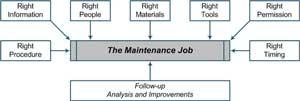|
A QUESTION for you. Could a business be financially successful if its financial accounts were managed out of a notebook or based on the information in someone’s head? Just imagine the difficulties in trying to complete the end of year tax returns and financial statements. So why is it that many asset-centric organisations try to take this approach – managing the maintenance services based on the information within a notebook or someone’s head? And typically it is those companies with a finance management system that prevent a maintenance department from selecting and implementing a Computerised Maintenance Management System (CMMS) due to the “costs”. However, what is the cost of not having a CMMS in place? It’s normally very high. Therefore if an asset-centric business is serious about improving its asset performance through improved maintenance performance, they must have a CMMS in place for use as their “management tool”. And I stress that the CMMS is only a “management tool”, it is not a maintenance programme which will provide the maintenance department with a ‘silver bullet’ to solve all maintenance problems. Putting it simply, the CMMS “tool” is there to assist the maintenance team in making the correct decisions about ‘doing the right maintenance job at the right time’ in order to improve asset performance. If your business either does not have a CMMS application, has one that is not effective, or, has one of those ‘in-house built’ applications, then it’s time to address the situation. The selection of the CMMS needs to be based on the management functions that the Maintenance Department currently undertakes and where it wants to advance to. OpEx Management has been involved in a number of successful CMMS selection and implementation projects throughout • Completion of a Maintenance Effectiveness Review (MER) to understand where the maintenance service is currently at and where it needs to go in terms of performance improvement. The results of the MER process can then be used in the development of a solid business case to support the capex approval process. • Completion of a “CMMS Discovery Workshop” where the benefits of a CMMS application are explored in detail and the functional requirements for the business are determined. During this workshop the “needs” and “wants” of the CMMS will be determined. Such discussion points would include whether a Tier 1, Tier 2 or Tier 3 application is needed, the number of User Licences needed, and whether a Standard-alone only, Enterprise-wide and/or Web-hosted solution is required. • CMMS Demonstrations by the application providers in terms of how the CMMS would be used by the business in their own working environment. • Site visits and reference checks with other businesses that are using the CMMS to get the “warts and all” story about how good the CMMS actually is from an end-users perspective. Once the above four steps are completed, the maintenance management team will then be in a strong position to select and, more importantly, successfully implement a CMMS. |
Other factors There are a number of other factors that need to be considered which will impact on the effectiveness of the CMMS. Consideration to the resource and cost requirements of the following key factors should occur: • Development and implementation of a five-level Asset Hierarchy Structure – a fundamental requirement of any good CMMS application. • Mapping of the business processes associated with the management and delivery of the maintenance services – in particular, the Maintenance Planning and Scheduling Policy. • Training of all personnel in the use of the CMMS. • Development of an Asset Criticality Rating process for effective maintenance planning and management. • What local support is available for the CMMS application. Financial considerations The cost associated with a CMMS application can vary significantly in terms of initial financial outlay. As a typical rule-of-thumb the total cost of a CMMS application can be defined as the ‘3 x 1/3 rule’ – that is, one third of the cost is the software licence, the next third is implementation and training costs and the final third is IT hardware costs. However, these costs can be managed effectively when consideration is given to the following main contributors to the overall cost: • The type of maintenance management strategy currently in place and where this is moving to in the future. • The type of CMMS application desired (i.e. Enterprise-based application, standalone application, Web-hosted application, etc). • The number of licensed users. • Whether a single site or multiple site installation is required and how roll-out will occur. • What current IT systems are currently in use (noting that a Web-based Hosted CMMS can offset these costs significantly). • Third party IT system integration (i.e. ERP, SCADA, Condition Monitoring, B2B integration, etc). Based on OpEx’s experience (both within our consulting business and our outsourced maintenance services business), the initial financial outlay can range from $10,000 up to hundreds of thousands of dollars. However in saying this, the financial return for implementing a CMMS application as part of an overall Maintenance Improvement Project can be in excess of 40 percent IRR based on a three year financial evaluation period. This result in itself can therefore justify the selection and implementation of a CMMS application that is specific to your organisation. Article by Mike Killick of OpEx Management – a leading maintenance management consulting business and the
Enquiries: mike.killick@opexgroup.biz
|






